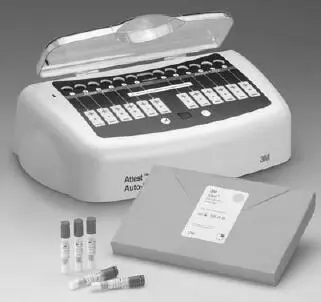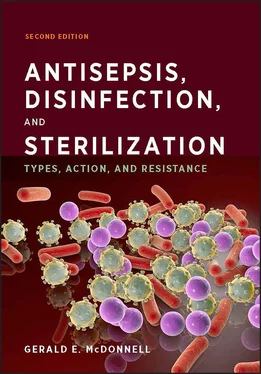Finally, in-use testing is designed to test the product or process under the actual conditions of use. These tests can be designed to test biocidal efficiency on a given surface, including routine microbial sampling of a surface using a recovery method (e.g., a swabbing or elution method). The efficiency can be determined before and after the application of a product or process with the estimation of the associated bioburden, which is defined as the population of viable microorganisms on or in a product, surface, or area. In some applications, in-use testing is recommended to actively monitor the success or failure of a product or process over time. Examples include the routine sampling of a reusable medical device, swabbing of a food contact surface, and verification of the operation of disinfection and/or sterilization equipment (examples of test methods are given in Table 1.20).
TABLE 1.20 Examples of simulated-use and/or in-use tests and/or guidelines a
| Reference b |
Title |
Summary |
| ASTM E1837-96 |
Standard Test Method To Determine Efficacy of Disinfection Processes for Reusable Medical Devices |
Simulated-use testing for the effectiveness of a disinfection process for reprocessing reusable medical devices using bacteria, viruses, and/or fungi |
| ISO 11737-1 |
Sterilization of Medical Devices—Microbiological Methods—Part 1: Estimation of Population of Microorganisms on Products |
In-use testing guidelines for estimation of the population of viable microorganisms (or the bioburden) on a medical device |
| ISO 14698-1 |
Cleanrooms and Associated Controlled Environments—Biocontamination Control, Part 1: General Principles and Methods |
In-use testing guidelines for the assessment and control of biocontamination within a cleanroom environment |
| WHO |
Guidelines for Drinking-Water Quality |
Guidelines for the microbial and chemical safety of drinking water, including water-testing methods for monitoring water disinfection efficacy |
| ASTM E1174-94 |
Standard Test Method for Evaluation of Healthcare Personnel Handwash Formulations |
Simulation to test the activity of an antiseptic on the hands using an artificial inoculum of Serratia marcescens |
| ASTM E1173-01 |
Standard Test Method of an Evaluation of Preoperative, Precatheterization, or Preinjection Skin Preparations |
In-use test for the activity of an antiseptic to reduce the resident microbial flora of the skin |
a Simulated testing uses an artificial inoculum, and in-use testing uses the normal bioburden present on a surface or device.
b ISO, International Standards Organization;ASTM, American Society for Testing and Materials;WHO, World Health Organization.
1.4.2.3 BIOLOGICAL, CHEMICAL, AND OTHER INDICATORS
Indicators are routinely used to check the effectiveness of various cleaning, disinfection, and sterilization processes. They include biological, chemical, and other (e.g., mechanical) indicators.
Biological indicators ( Fig. 1.23) consist of a standardized population of microorganisms inoculated onto a carrier material. They are particularly widely used in the monitoring and validation of sterilization processes. Bacterial endospores are commonly used as the test microorganisms, as they are generally nonpathogenic and stable and demonstrate high resistance to various sterilization processes ( Table 1.21). Defined bacterial strains, obtained from standard culture collections (e.g., the American Type Culture Collection), are used. The intrinsic resistance of the inoculated spore population can vary depending on the culturing methods used and other variables. Therefore, to standardize the use of biological indicators, manufacturers test each batch of indicators to determine the population and the relative resistance to a given sterilization process (e.g., D -value determination at 121’C with saturated steam and at 55 °C, 800 mg of ethylene oxide/liter, and 70% relative humidity for ethylene oxide). Depending on the application, other microorganisms may be used, but to a much lesser extent.

FIGURE 1.23 Example of a self-contained biological indicator. The 3M Attest 1292 Rapid Readout Biological Indicator is used to monitor steam sterilization cycles. Reproduced with permission of 3M Health Care.
The carrier can consist of any material, with typical examples being paper, stainless steel, glass, and plastics. In its true definition, a biological indicator consists of the inoculated coupon placed into a “primary pack,” which can be a protective envelope or pouch, or within an assembled vial or ampoule. In their simplest form, biological indicators are present within a protective envelope, and following exposure to a given sterilization process, the inoculated coupon is aseptically removed from its pack and incubated in a specified growth medium to determine the presence or absence of spore viability. Due to the release of dipicolinic acid (see section 8.3.11) upon germination and outgrowth of the spores, pH indicator dyes can be used in the growth media to indicate the presence of viability before visible growth (turbidity) is observed. To minimize aseptic handling, self-contained biological indicators that include the inoculated carrier within a vial containing a sealed ampoule of growth medium have also been developed ( Fig. 1.23). Following exposure, the medium ampoule is broken to allow incubation without handling of the coupon. Further “rapid-review” biological indicators are available that detect the presence of certain endospore enzymes (e.g., (α-D-glucosidase) whose destruction by heat correlates with the loss of viability of the spore; the presence of enzyme activity can be detected fluorimetrically and can give a rapid indication of spore viability (usually within 1 to 4 h). In addition, these indicators are further incubated to demonstrate the presence or absence of growth, as for traditional biological indicators. Various standards that define the requirements for and use of biological indicators are given in Table 1.22.
TABLE 1.21 Bacterial-endospore species used to monitor and validate sterilization processes
| Sterilization process |
Biological indicator |
| Moist heat |
Geobacillus stearothermophilus |
| Dry heat |
Bacillus atrophaeus |
| Irradiation |
Bacillus pumilus |
| Ethylene oxide |
Bacillus atrophaeus |
| Low-temperature steam formaldehyde |
G. stearothermophilus |
| Hydrogen peroxide vapor |
G. stearothermophilus |
Chemical indicators change color (or provide another visible change) on exposure to a given disinfectant or sterilization process ( Fig. 1.24). They can range from simple process indicators that indicate exposure to a given process parameter (e.g., exposure to heat, but not necessarily at the right temperature and for the right amount of time) to more specific integrator indicators, which change color only on exposure to multiple variables (e.g., temperature and time for steam sterilization and concentration or time, temperature, and humidity for ethylene oxide sterilization). They can be classified in various ways, and an example is given in Table 1.23.
Chemical indicators are widely used, as they give an instant result and in some cases (as with some integrators) can be correlated to a biological indicator result. Applications include specific direct parameters that are required for disinfection or sterilization (e.g., verification of the presence of a minimal concentration of a biocidal formulation prior to use or that a range of conditions have been met in a sterilizer), but also other, indirect variables that are important to the efficacy of the process (e.g., Bowie-Dick tests are used to confirm the adequate removal of air in prevacuum-type steam sterilizers [see section 5.2]). Examples of various standards that define the requirements for and use of chemical indicators are given in Table 1.24.
Читать дальше













